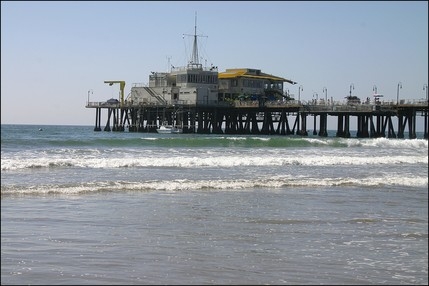
SM PIER — City staff is expected to present its recommendations to make significant changes to the management of the Santa Monica Pier and structure of the non-profit organization that helps run it at the Pier Restoration Corporation’s meeting Thursday.
Officials hope that the proposed reorganization will make Santa Monica’s iconic tourist destination self-sufficient and run more smoothly, said City Manager Rod Gould.
“Without a doubt, it’s one of the city’s most important, beloved assets. The impetus for the study and the recommendations were to study how to take better care of the pier, and maximize its potential to take better care of the community,” Gould said.
The recommendations represent a major overhaul, including cutting the number of positions on the PRC board and allowing the Convention and Visitors Bureau, Chamber of Commerce and Pier Lessees Association to fill three of the remaining seven seats.
The other four would be appointed by the City Council.
Staff also recommends creating an on-site Pier Management Office to handle the day-to-day operations of the pier, including custodial cleanup, tenant relations, parking, financial oversight of the Pier Fund, leasing and capital improvements.
That management office would work in tandem with the PRC, which staff proposes to rename.
The name Pier Restoration Corporation is a holdover from a 15-member body formed in 1981 to help rebuild the pier’s physical and economic infrastructure after it was destroyed by a storm.
Times have changed, Gould said.
“We’re no longer in the business of restoring the pier,” Gould said. “Now we need to be better stewards of the pier.”
The newly-renamed PRC would be responsible for helping to form the vision of what the pier is and what it will become over the next several years as City Hall embarks on the development of a Master Plan for the area.
It would also help craft the lease guidelines that the Office of Pier Management would then follow, as well as policies for events and marketing.
Meanwhile, PRC staff would focus their attention on garnering donations, sponsorships and other monetary support.
The report was crafted out of several studies conducted by Urban Place Consulting, a company owned by the pier’s interim executive director, Steve Gibson.
Its final recommendation, outlined above, was not one of the options outlined in Urban Place Consulting’s reports, although the company did sign off on the concept, according to the staff report.
Gibson did not want to comment on the studies prior to Thursday’s meeting.
The departure of the previous executive director, Ben Franz-Knight, cleared the way for the studies, giving officials the chance to examine the state of the pier, Gould said.
They looked at how the pier was managed and compared it to similar landmarks like Pikes Market in Seattle and Navy Pier in Chicago.
The conclusion: management of the pier needed to be streamlined.
Today, many of the functions of the pier, including janitorial operations and safety, fall under the responsibility of several departments in City Hall, which hampers the ability of each to coordinate.
“There are five different departments that are responsible for the pier, and no one coordinating,” Gould said. “They move past each other, and it’s hard to get things done.”
The involvement of the city makes leasing difficult as well.
Pier vacancies are filled using a method called “request for proposal” that is common amongst city governments but is unfamiliar to many businesses. The businesses that do respond to the RFP must be vetted by staff and then go before the PRC.
If the PRC members dislike the proposal, it dies right there, Gould said.
The reorganization would allow City Hall to change those processes, give the pier more operational flexibility and hopefully get its ledgers into the black.
Between 2009 and 2011, the pier has increased its revenues from $38 million to $43 million. It generates $182,849 in sales taxes, business license taxes and parking taxes, as well as another $20,900 in film permits, according to the staff report.
Although it’s had some success, the pier will still need a General Fund subsidy to the tune of $1.4 million in fiscal year 2011-12 and $5 million in fiscal year 2012-13, according to the two-year budget adopted in June.
If city officials choose this reorganization plan, the re-formed PRC will have two years to work out the future of the pier, and prove to City Hall that it can handle some of the parts of its task that are unusual for non-profits, like marketing, filming and special events, Gould said.
ashley@www.smdp.com







